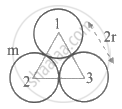Advertisements
Advertisements
प्रश्न
Three uniform spheres, each having mass m and radius r, are kept in such a way that each touches the other two. The magnitude of the gravitational force on any sphere due to the other two is
विकल्प
`G m^2/r^2`
`(Gm^2)/(4r^2)`
`sqrt(2) (Gm^2)/(4r^2)`
`sqrt(3) (Gm^2)/(4r^2)`
उत्तर
`sqrt(3) (Gm^2)/(4r^2)`
Explanation:

Force om 1st sphere `vecF_1 = vecF_12 + vecF_13`

Now, `|vecF_12| = |vecF_13| = (GM^2)/(2r)^2 = (Gm^2)/(4r^2)`
The resultant of the attractive forces `vecF_12` and `vecF_13` is determined by the parallelogram law of vectors since they point in opposing directions.
∴ F1 = `sqrt(F_12^2 + F_13^2 + 2F_12F_13 cos theta)`
∴ F1 = `sqrt(2F_12^2 + 2F_12^2 cos 60^circ)`
∴ F1 = `sqrt(2F_12^2 + F_12^2)` .....(∵ cos 60° = 1/2)
∴ F1 = `sqrt(3)` F12
∴ F1 = `sqrt(3) (Gm^2)/(4r^2)`
Because of the symmetry of the design, each sphere will experience equal magnitude force.
